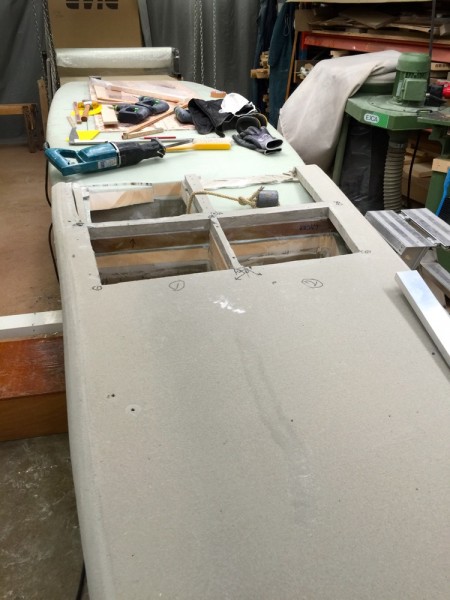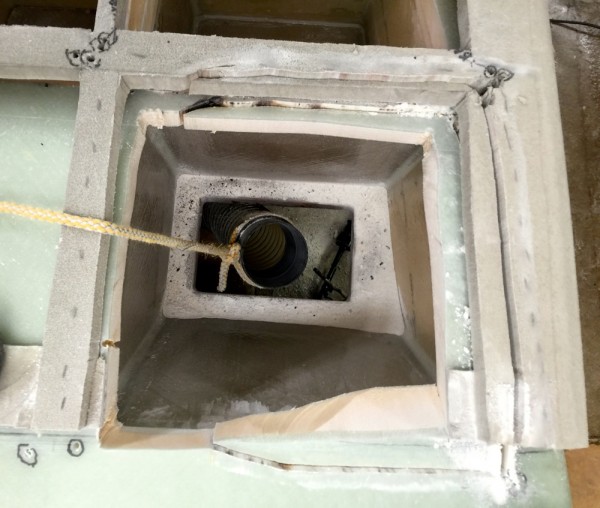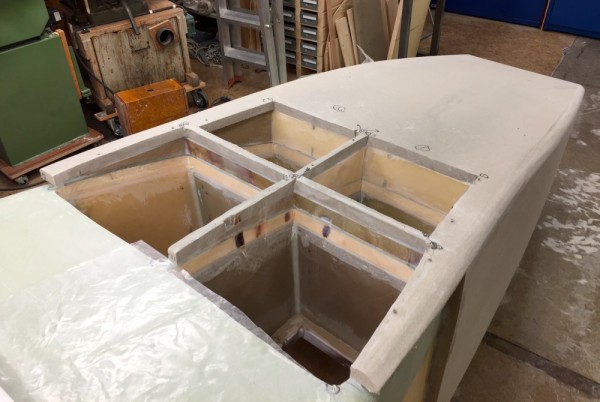When I stretched Ex Lex I got double planking and bottom for about 60 cm. The solution is to remove the extra inner bottom. Se pictures. Unfortunately I can only do that from the outside, but I will gain about 30 liters of stowage space and that will be worth it because those 30 liters of food might keep me alive for 2 or 3 weeks. In total I estimate that the stretching will add 250 or so liters of stowage.
As I said before Ex Lex started out as an experimental boat with two purposes, to teach me about the new rigging, leeboards and others things, also to give me a bit of fun I the summers.
Few plans survive first contact with reality. When I saw Yrvind Ten and Ex Lex next to each other I realized how ridiculous Yrvind Ten and the project was. I used my good recipro saw and a carbide tipped blade. The boat was well built, but after a busy weekend, two friends helped me to drive the pieces to the dump.
Ex Lex the new boat will have fewer problems crossing the Atlantic equator southbound due to her much longer waterline. Few if any small boats have done that crossing.
That passage is special because you meet the south east trades head on at the same time as the equatorial current carries you westwards with a speed of about one knot or 24 miles a day and than if you have not made enough southing before you hit the longitude of eastern Brazil you will be carried back up to the North Atlantic and will have to do as the square riggers of old days had to do, make a circuit of the North Atlantic before you can try again.
The southeast trade has a fetch of several thousands of miles and blows freshly. The waves you are heading into are impressive.
I have done that passage three times. Analyzing the forces acting on my boats I have come to the following finding.
I knew, and it is well known fact that a small floating artifact in big waves is subjected to a centrifugal force that is considerable. On top of the wave you are lifted, in the trough you are depressed. On top of the wave the centrifugal force is subtracted from gravity. There it’s like being on the moon, you weigh less. In the trough gravity and the centrifugal forces are added. There it’s like being on Jupiter, you weigh more.
A displacement boat can only travel as fast as its wave system and when that wave system is on top of the wave it weighs less, therefore it and the boat travels slower. The speed of a wave system depends on the forces acting on it. The speed is high if forces are high and slow if forces are small. On top of a wave where there are small forces. Therefore, there a displacement boat cannot travel as fast as on flat water or in the trough its being slowed down.
Another consequence of the boats little weight on top of a wave is that she is losing stability. She heals over, losing driving force and lateral resistance. People think this extra healing at the top of a wave is due to more wind. The fact is, its normal to lose more than half the stability due to the influence of the centrifugal force. Stability is a function of weight and weight is lost at the top of the wave.
Another complication is the surface current that on top of the wave is travelling with the wind against you. This means that three bad things oppose a small boat going to windward in big waves when trying to cross Atlantic equator from north to south.
The boats sail force is not big enough to overcome this momentarily increased resistance; therefore the boat has to borrow a lot of kinetic energy. That slows her down.
Now with Ex Lex much longer waterline I am more confident of making it across the equator. If I had tried sailing with the late Yrvind Ten my best chances would have been to hug the African coast, but there, there are pirates. Down in the Southern Ocean it’s a question of surviving storms and spending time and that is a different set of problems that I do not worry so much about.
Some pictures:
Above looking nice.
Holes are cut.
A lot of cutting, grinding and unpleasent work.
Starting the rebuild.
To be continued…
Regards Yrvind.




